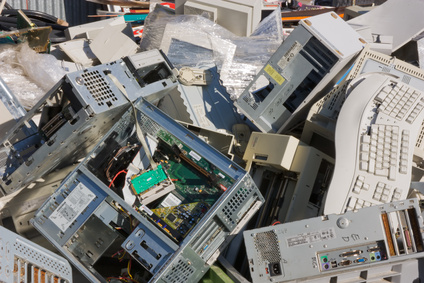What we recycle
|
|
Electronic Contents
Electronic equipment contains metals and other materials that can be hazardous to human health and the environment if they are not properly managed.
Cadmium - found in chip resistors, infrared detectors, and semiconductors.
Cadmium can accumulate in,and negatively impact, the kidneys. Cadmium is persistent, bioaccumulative, and toxic. The principal exposure pathway is through respiration and through our food.
Lead - found in glass panels in computer monitors and in lead soldering of printed circuit boards.
Lead can cause damage to the central and peripheral nervous systems, blood systems, and kidneys in humans. Lead has also been shown to have negative effects on the development of childrens' brains. Lead can accumulate in the environment and have a detrimental effect on plants, animals, and humans. Consumer electronics may be responsible for 40% of the lead found in landfills. The principal pathway of concern is lead leaching from landfills and contaminating drinking water supplies.
Mercury - found in thermostats, position sensors, relays and switches (e.g., on printed circuit boards), discharge lamps, and batteries. It is also used in medical equipment, data transmission, telecommunications, and mobile phones.
When mercury make sits way into waterways, it is transformed into methylated mercury in the sediments. Methylated mercury accumulates in living organisms and travels up the food chain. Methylated mercury can cause brain damage. The principal exposure pathway is through our food.
Brominated Flame Retardants - found on printed circuit boards, components such as plastic covers and cables as well as plastic covers of televisions
Although less is known about BFRs than some other contaminants of concern, but research has shown that one of these flame retardants, Polybrominated Diphenylethers (PDBE) might act and an endocrine disrupter. Flame retardant (Polybrominated Biphenyls (PBB) may increase cancer risk to the of the digestive and lymph systems. Once released into the environment through landfill leachate and incineration they are concentrated in the food chain.
Services we provide
|
Recycling of end-of-life electronics |
|
Recycling of excess inventories and obsolete parts |
|
Asset management |
|
Testing, repair and reuse |
|
Parts and material Reclamation |
|
Customized reporting |
|
Environmentally sound processing of all materials |
Plastics
Plastic poses one of the biggest challenges in recovering material from electronic equipment for two reasons. First, plastics are often attached to these other materials such as metal screws and inserts, coatings and paints, foams, and labels. If not separated from each other, these other materials will contaminate the plastics. Second, manufacturers use many different kinds of plastic in electronic equipment and it is both difficult and costly to sort for utilization in markets requiring single resin feedstocks. There are also limited markets for the mixed plastics stream. Recently, however, these plastics have found a market in roadbed fill. In the future, EPA hopes these plastics can be used in flooring, computer, and automotive parts.
580 tons of computer plastic is discarded each year. It contains methyl bromide, a Category 1 acute toxin and a potent ozone depleter.
Since manufacturers use many different types of plastic in electronic equipment, it is the most challenging to recycle. These plastics often include contaminants such as metal screws and inserts, coatings and paints, foams, and labels. Currently, plastics from electronic equipment are both difficult and costly to sort for single resin feedstocks markets and there are limited markets for the mixed plastics stream. Also, plastics can be treated with brominated flame retardants, making them harder to recycle and possibly dangerous to those exposed to them.

 Global eRecyclers
Global eRecyclers